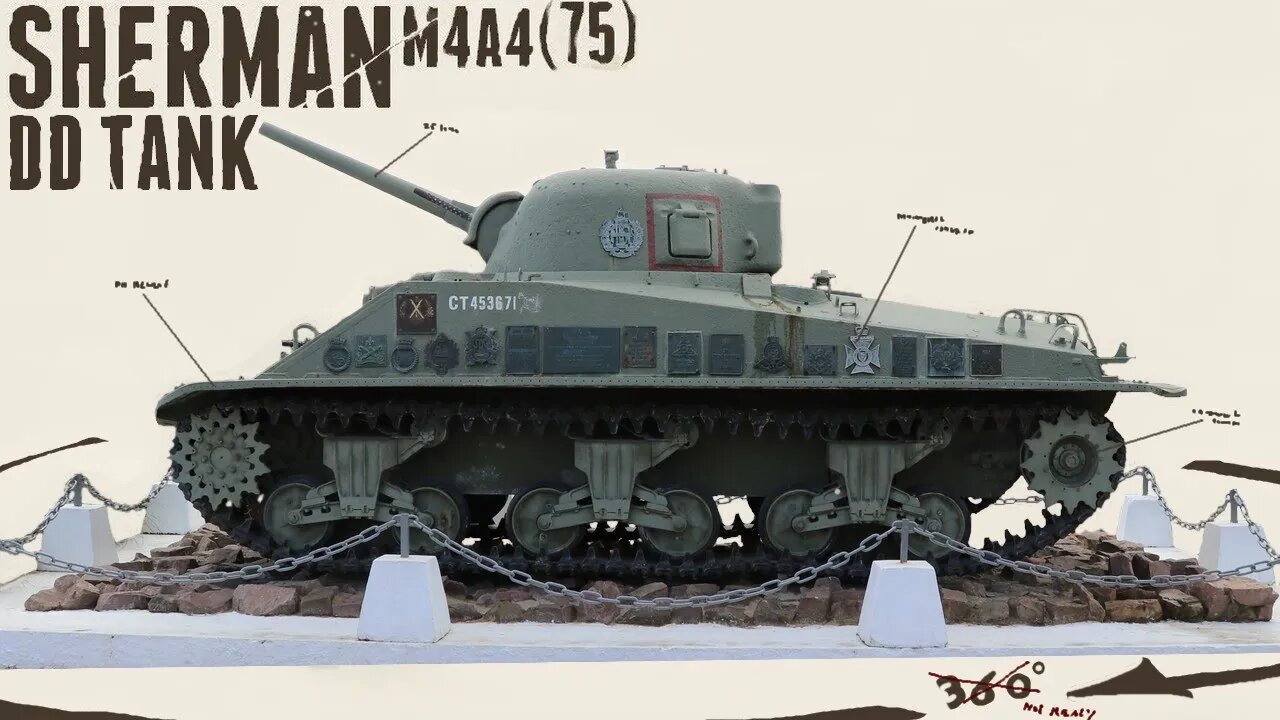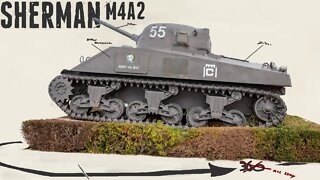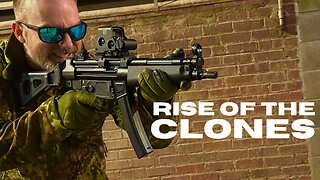Premium Only Content

Sherman M4A4(75) DD Tank - Walkaround - Juno Beach.
The Sherman DD (duplex Drive) was a
Hobart’s Funnies tank developed after
the disastrous Dieppe Raid of August 19th, 1942.
These vehicles would allow crew to carry
out their objectives, but remain protected.
A prototype of a DD Valentine tank began trials
on 21 May 1942, although it subsequently sank.
In June 1942, permission was given by the Ministry
of Supply for the manufacture of 450 Valentine DDs.
It later became clear that the Sherman was more
suitable for use with a screen than the Valentine and
the DD screen was adapted for the Sherman by April 1943.
The DD canvas was attached to this boat shaped
metal platform welded to the tank hull.
One reason for this was that the Sherman could move in
the water with its gun
forward ready to fire as soon as land was reached.
The whole idea behind the Duplex Drive tanks was
the science of displacement.
If you can push out enough water, roughly 30 tonnes of water,
the same weight of the Sherman tank, then the tank will float.
Propellers were added at the back of the tank
to propel the tank to shore.
Two propeller drives were added at the rear of the tank
and two propellers were fixed onto the drive units.
The lower hull was sealed
and the canvas screen was attached to a new metal boat
shaped platform that went around the tanks hull.
Once the tank was on the beach the canvas screen
would be collapsed
and the tank would be able to engage enemy targets.
A system of compressed air bottles were used to inflate
the rubber tubes to give the canvas curtain rigidity.
Additional metal hinged arms and props were attached
to the tank hull
to assist keeping the canvas in the correct position
This Sherman DD has been used by the
Canadian 6th Armoured Regiment.
It would have been launched at 07:45,
3000 meters from the coast.
But this one and several DD tanks immediately sank to the bottom.
On this other DD tanks were unloaded at a shorter distance
(800 meters) from their Landingcraft Tank.
These tanks did what they came for, they fired on the German positions.
Despite the resistance,
the landing here went quite well. In the evening, 21,500 men
and 3,200 vehicles had landed on Juno Beach.
It was recovered in 1970 with several other tanks with a
recover lead by Leo Gariepy and placed here at
the memorial to the 1 st Hussars.
The tank also bears the insignias of the Canadian regiments
which took part in the D-Day landings and the Battle Normandy.
■ So want to help keep me and the channel going?
Please consider buying a cup of coffee!
https://www.buymeacoffee.com/panzerpi...
supporting me on Patreon and Buymeacoffee will get you access to extra content for three channels in total.
■ Support me on my Patreon https://www.patreon.com/Panzerpicture
■ Or buy me a Coffee on https://www.buymeacoffee.com/panzerpi...
■ Store: teespring.com/stores/panzerpicture-2
■ Information obtained from several sites.
■ Wikipedia
■ tanks-encyclopedia
■ the.shadock.free.fr/Surviving_Panzers
■ preservedtanks
■ pantser.net
■ the.shadock.free.fr/Tanks_in_France
■ Some music is from the YouTube Audio Library.
■ Music used:
EpidemicSound.com
Copyright fair use notice
All media used in
this video is used for
the purpose of education
under the terms of
fair use.
All footage and images
used belong to their
copyright holders.
-
 3:42
3:42
Walking with Panzers
2 years agoSherman M4A2 Berry-au-Bac - Rainy Walkaround - Arromanches.
6 -
 28:23
28:23
Dave Portnoy
15 hours agoDavey Day Trader Presented by Kraken - December 23, 2024
98K32 -
 59:29
59:29
BonginoReport
6 hours agoTrump, Murder Plots, and the Christmas Miracle: Evita + Jack Posobiec (Ep.110) - 12/23/2024
111K91 -
 2:59:14
2:59:14
Wendy Bell Radio
9 hours agoNothing To See Here
97.4K56 -
 2:12:18
2:12:18
TheDozenPodcast
1 day agoIslam vs Christianity: Bob of Speakers' Corner
93.9K23 -
 14:36
14:36
The StoneZONE with Roger Stone
1 day agoRoger Stone Delivers Riveting Speech at Turning Point’s AMFEST 2024 | FULL SPEECH
116K27 -
 18:59
18:59
Fit'n Fire
15 hours ago $7.16 earnedZenith ZF5 The Best MP5 Clone available
78.4K3 -
 58:34
58:34
Rethinking the Dollar
1 day agoTrump Faces 'Big Mess' Ahead | RTD News Update
56.6K5 -
 5:35
5:35
Dermatologist Dr. Dustin Portela
1 day ago $2.80 earnedUnboxing Neutrogena PR Box: Skincare Products and Surprises!
69K5 -
 11:20
11:20
China Uncensored
23 hours agoCan the US Exploit a Rift Between China and Russia?
79.8K26